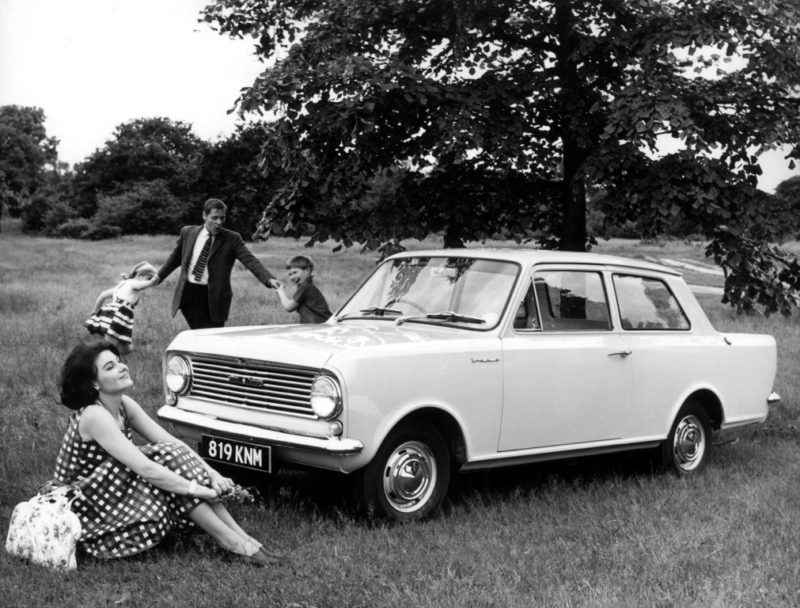In August 1963 Vauxhall presented its first new mid-range model after the Second World War with the Viva HA. This Vauxhall Viva was the start of a seventeen-year period in which three generations of the Viva were built. The first series was to be produced until 1966, and put Vauxhall on the map in this class. In total he was sold some 310.000 times.
The Viva (internal code HA) got a 1057 cc overhead valve engine with 1 Solex B30 PSE carburettor and an underlying camshaft. With this engine, the Viva was good for a top speed of 123 kilometers per hour. Vauxhall connected a fully synchronized four-speed gearbox to the power unit. The power was put on the road via the rear wheels. David Jones and Maurice Platt were responsible for the design of the car, which was notable for its use of space, good all-round visibility and a fairly light build. The Vauxhall Viva HA from Ellismore shared the platform with the German GM brother Opel Kadett-A, which was built at the sister plant in Bochum. Interestingly, there is often speculation about the joint development of these two European GM models, but little is known.
Old-fashioned chassis, popular subframe
The chassis was wonderfully old-fashioned in today's perspective. The wheel suspension consisted of double wishbones with transverse leaf springs, which was mounted on a subframe together with the rack and pinion steering and engine mounts. That construction was loved by Hot Rod builders. This was also because the subframe offered space for varying with larger engines. At the rear, Vauxhall mounted a rigid rear axle. It was suspended with semi-elliptical longitudinal leaf springs. The axle was guided by a drawbar, the construction could lead to wobbly handling. The non-powered braking system consisted of drums all around. The Viva buyer could order front disc brakes at an additional cost. Vauxhall opted for the installation of an electrical system with 12 volts, which was not always common practice in those years.
On the way to the SL90
Initially, Vauxhall only offered the Viva HA in the basic and De Luxe variants. It took until the end of 1965 before Vauxhall brought the significantly more luxurious SL. It was distinguished by double strips on the sides with colored strips in between, large wheel covers, a more luxurious interior and three-part rear lights. The cylinder capacity of the Viva HA remained stuck at 1.057 cc for a career. It was available in two variants: the standard motor with 32 KW / 44 HP and the more powerful “90” with 40 KW / 54 HP. This increase in power was achieved, among other things, thanks to a compression ratio increased to 9: 1, compared to a ratio of 8,5: 1 with the standard engine. The “90” was good for a top speed of 135 kilometers per hour, which is why this motorization got disc brakes. Unsurprisingly, the hit in the series was the SL90.
Globetrotter with different names
The Viva went around the world. Across the Atlantic, it was sold as Envoy Epic by Pontiac / Buick dealers. In Australia it went by the name Holden HA, while it was sold as Vauxhall Epic in France and some North African countries. The closed Viva-van version was called Bedford HA. It remained in production until 1983. He was loved by entrepreneurs and state-owned companies. Martin Walter Ltd. transformed the (heavier version of the) Bedford HA into a station wagon. It was marketed as the Bedford Beagle. And this again formed a grateful basis for the conversion to a small camper, the Bedford Roma.
Built more than 300.000 times
Back to the Vauxhall Viva HA. The first post-war car of the British GM subsidiary in this class was sold. He nicely brought Vauxhall back into a class that was still quite well occupied during the heart of the 1s. The prospective buyer of the Kadett-A, the Cortina Mk4, the Taunus P16, the Beetle and the ADO 310.000 from BMC had an alternative. That was appreciated, both in Europe and beyond. The Viva HA was sold nearly 1966 times by Vauxhall before acquiring the Viva HB as its successor in XNUMX.



After 7 driving lessons in a Vauxhall Viva I immediately passed my driving test on December 5, 1969. With my father I had already been allowed to practice his Opel Kadett A in the woods and mastered the basic tricks of driving, twisting, pulling downhill and parking.
The Viva was indeed a copy of the Kadett.
Pet name (like brother Kadett) was mop. There would have been few times when the occupants wanted to enjoy full top speed.
The van version was not HA but HAV in my opinion.
Dear Wim.
Thanks for your response. The model name of this orderer was indeed HA, but the coding HAV does indeed occur in relation to this type. However, this is a chassis code, used for the heavier HA versions. The lighter orderers had the code HAE, at least according to my information.
Thanks again and have a nice evening.
Hello Erik, I used to work at van Gorp at the Soerweg in Rotterdam and there you had the Bedford HAV. This was the delivery version of the Vauxhall. I think HAV stood for HA Van. They had the same nose but with Bedford on the grille. A lot of them drove on the Shell Pernis site and I think without a license plate because of the insurance and road tax. These HAVs were under maintenance at the van Gorp branch on the Brielaaan.
These cars were rented by Shell at Van Gorp, at the time my boss allowed me to make the rental calculations with more/less kms. I think Shell had about 180 on the road.